How To Do A Push Up With Perfect Form
Instructions | Benefits | Form Tips | Mistakes | Variations | FAQ
If you’ve been following BuiltLean for a while, you know I love push ups.
Push ups are a staple upper body exercise that demand core control and full-body strength.
You can do push ups anywhere to stay fit and strong. You can even start your day with push ups to get the blood flowing and make you feel empowered.
While I’ve written extensively about push ups in several articles and multiple youtube videos, I decided to synthesize them together into this one post.
Mục Lục
Contents
Push Up Benefits
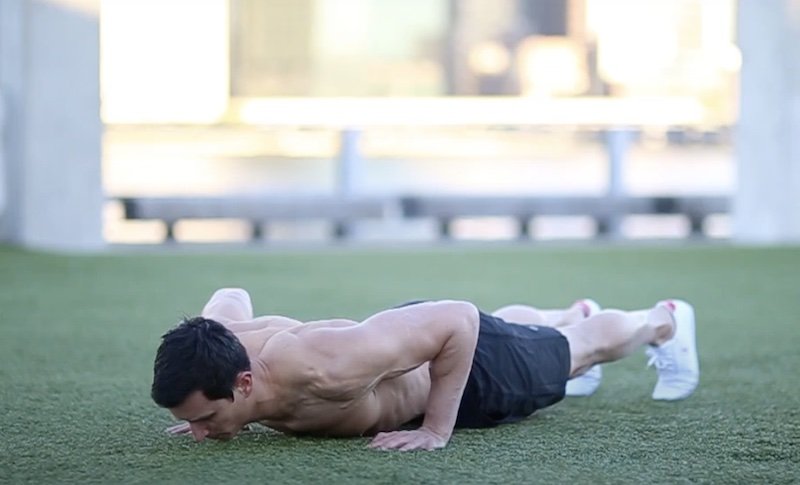
1. Do Push Ups Anywhere – You can do push ups anywhere because they only require your body weight. No fancy or expensive equipment required.
2. Build Upper Body Muscles – Push ups engage your chest, shoulders, triceps, and core for a complete pushing exercise. If you are doing a bench press with weights, you won’t get the same core activation.
3. Build Pushing Strength – By keeping your body as one stiff plank while pushing away from the ground, you are building full body pushing strength that carries over to other fitness and athletic activities.
While pushups can be extremely beneficial to help improve your physique and muscle endurance, even people who have exercised for years may have improper push up form.
Push Up Instructions
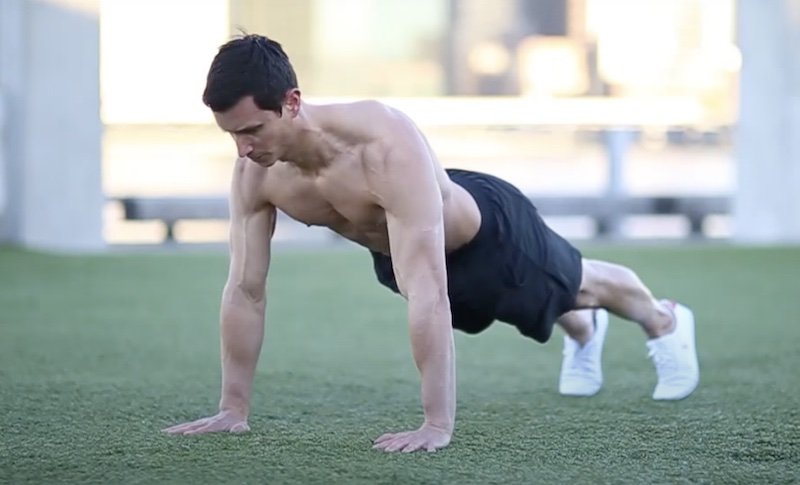
1. Drop to the ground on your hands & knees.
2. Step both feet backward so your arms & legs are straight
3. Lower your body until your chest grazes the floor.
4. Push away from the ground until your arms lock, then repeat.
Push Up Form Checklist
Here’s a 7 step checklist to make sure you use perfect push up form every time you do a push up.
1. Head & Neck Neutral
This is a common mistake for people who are not strong enough to complete a push up or have poor posture from working on a computer all the time. The head is forced forward and down in an effort to make the push up easier. Do push ups on an incline until you can easily keep your head in line with your torso as you do the push up in a slow and controlled motion.
2. Shoulders Back & Stable
Most beginners shrug their shoulders towards their ears, which forces more pressure on the triceps. Typically this is a result of weak chest muscles, or similar to the neck position, poor posture. Keeping your shoulders down, back, and stable will make the exercise more effective.
3. Hands Below Plane Of Shoulders
If you have not developed pushing strength, you will likely start with your hands above the plane of your shoulders and flare out your elbows. The air-push up is a brilliant tip that I learned from Brett Jones of StrongFirst to help you feel proper push-up form without actually doing a push up.
While standing straight, extend your arms in front of you so that the top of your palm is in line with the top of your shoulder. Pull your hands back toward your chest, then push out forward again. You’ll notice that your elbows are staying closer to your sides where they belong to help generate maximum power.
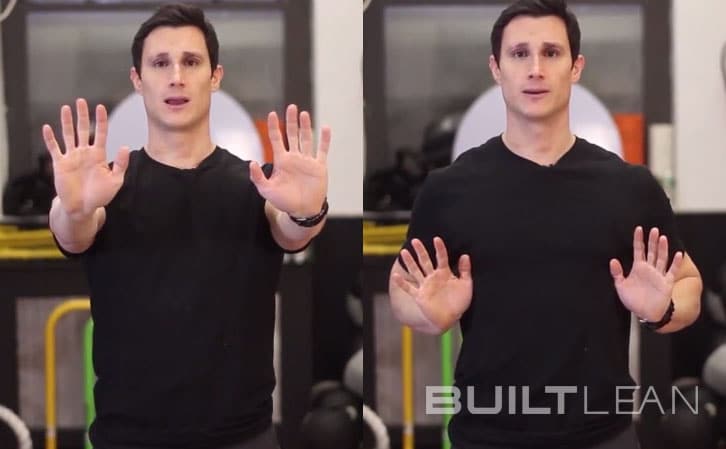
4. Pressure on Outside of Hands
While push ups are a great exercise, they can easily cause overuse injuries, especially in the wrists. Put the pressure of the weight on the outside palm of your hands, not the bottom of your hand/wrist, which is what I did for years.
The outside of your hand is very stable and strong, which explains why MMA fighters strike with the outside of their palm. You can pretend like you are gripping the floor to help keep the pressure off your wrists.
5. Hips and Torso Straight Like A Plank
In an effort to make the push up easier, beginners slouch their hip downward, or pushing their hips upward. By not keeping the hips and torso straight, the abs are almost taken out of the equation. Keep your hips in line with your torso to properly engage your abs and properly recruit the muscles as they were intended (chest, shoulders, triceps, and abs).
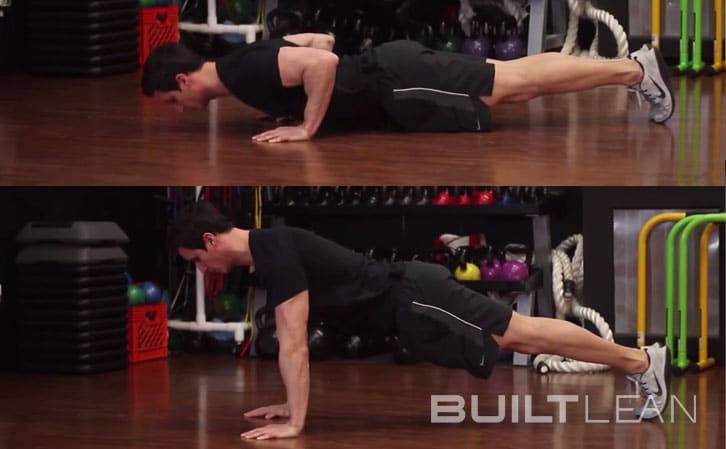
6. Full Range of Motion
I’ve heard a million times how you should never let your body dip below a 90 degree angle in your elbows. I think this came about because of shoulder concerns. In my opinion, I think you should use a full range of motion (just as with every other exercise) as long as it doesn’t hurt your shoulders.
In fact, if I couldn’t get the full range of motion and get that stretch in my pecs and shoulders at the bottom of the rep, I probably would never do push ups. Try to get your chest to slightly graze the ground, or come within an inch of the ground.
7. Controlled Tempo
I think this applies to most exercises along with the full range of motion. Control the descent and push up forcefully. It’s cool if the positive phase is very quick in the beginning, but in general, a 1 second up, 2 second down count is ideal. Controlling the tempo dramatically reduces risk of injury and substantially increases muscle stimulation.
Push Up Common Mistakes
These top mistakes are the inverse of the proper form checklist above.
1. Hands Too High Above Shoulders
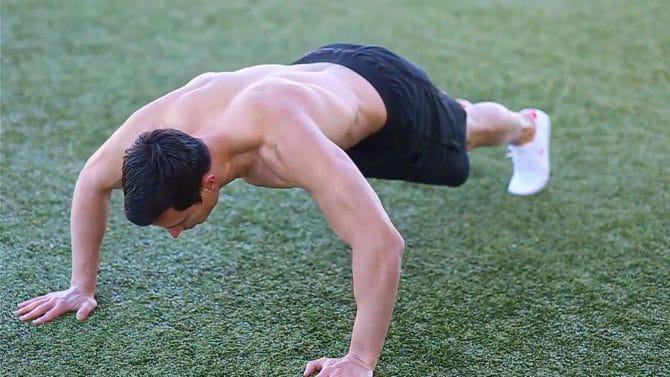
Improper hand placement is probably the most common mistake many men and women make.
Start with your hands closer to your body and below your shoulders. A proper push up with your hands below your shoulders while keeping your elbows near the sides of your body is harder than most people realize, so don’t be discouraged if this is very challenging at first.
If you can do 20 half-push ups with your hands and elbows out wide, you may be able to only do 5 or 10 with proper push-up form. The push up requires that you create “full-body tension”. If just one area lacks tension (i.e. has a leak), it will make the push up much harder.
I recommend starting with an incline push up where you use a bench, bar, or chair to elevate your body a couple of feet off of the ground. Then, gradually work down to the floor over time. You must build your strength.
Again, push ups may look easy, but when I teach men & women how to do push ups with proper form, they do A LOT fewer reps than they’re used to.
2. Shoulders Shrug Towards Ears

Similar to the first common mistake, shrugging your shoulders towards your ears can happen even if you have the proper hand placement. To prevent this from happening, you must contract your lats – the muscle underneath your armpits – to pull your shoulders away from your ears and into a stable & locked position.
If you’ve never done this before, it can take some time to figure out, and for your body to stabilize and build strength. But in the long run, you’ll learn how to “pack” your shoulders down and away from your ears, which makes you much stronger. When you are pushing or pulling heavy weight, your lats should always be contracted and your shoulders packed.
3. Not Keeping Hips & Core Stable
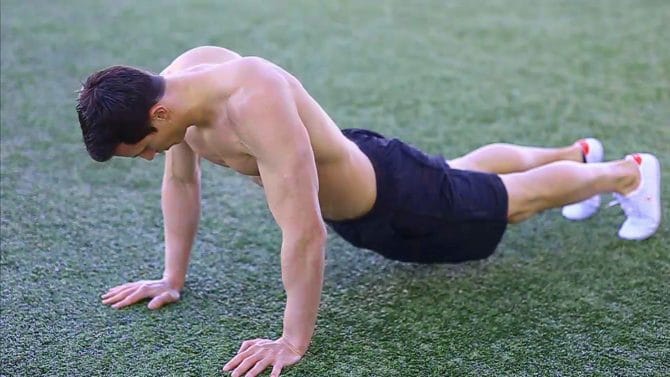
When you perform a push-up, the only parts of your body that should be moving are your arms. Everything else should be stiff as a board like a plank.
Ideally, your head, neck, shoulders, hips, knees, and feet should be roughly in one line that is completely straight and does not change. The push up when done properly is a very strong position that can help improve your core strength and stability.
If you lack core stability, or the ability to keep a rigid plank, push ups are not an appropriate exercise for you yet. Consider building your core stability by holding a 30-second forearm plank with your glutes contracted before working on push ups, or try push ups on an incline first.
To keep your hips and core stable, the trick is to lightly squeeze your glutes (butt muscles) and contract your quads as you do the push up. At first, this makes the push up harder, but also more effective.
You also want to avoid letting your hips slouch or drop as you do this. Contracting your abs, glutes, and quads will help prevent this. This is a subtle change that makes you much stronger, and is one of the ways that gymnasts build exceptional strength.
Push Up Variations
There are nearly endless variations of the standard push up, which can keep you engaged and building more strength.
Here are a few of the most common:
Push Up FAQ
1. How do I build strength to do push-ups?
Start doing push ups on an incline. Over time, lower the incline so that eventually you can do push ups on the ground. A slow and steady progression is superior for making push ups feel easy. Avoid knee push ups.
2. Why can’t I do push-ups?
You lack (1) pushing strength, (2) core stability, and (3) practice. Push ups get easier the more you practice them. Pushups are hard because you have not built neuromuscular coordination through practice.
3. What muscles do push ups work?
Push ups work your chest, shoulders, triceps, & core muscles.
4. How to get better at pushups?
Practice, practice, practice. The more push ups you do with proper form, the better you’ll get. If you practice poor form, you will continue to struggle.
5. How long does it take to be able to do push-ups?
It depends on your starting point. It could take a couple of weeks to a couple of months. Start on an incline, lower the incline over time, then do them on the floor.
6. How many push ups should I do a day?
A few sets push ups a day for a total of 20-30 reps is a good starting point. Over time, you can do more push ups, eventually 100 or more in a 3 to 5 sets as you progress.
7. How do I add push ups to a workout routine?
If push ups are easy for you, do them as a warm up or at the end of a workout. If they are difficult, build them into your workout for 3 sets. Here’s a full-body workout you can do with push ups.
962
Shares















![Toni Kroos là ai? [ sự thật về tiểu sử đầy đủ Toni Kroos ]](https://evbn.org/wp-content/uploads/New-Project-6635-1671934592.jpg)


